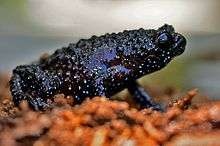Melanobatrachus
| Melanobatrachus indicus | |
|---|---|
 | |
| Scientific classification | |
| Kingdom: | Animalia |
| Phylum: | Chordata |
| Class: | Amphibia |
| Family: | Microhylidae |
| Subfamily: | Melanobatrachinae |
| Genus: | Melanobatrachus Beddome, 1878 |
| Species: | M. indicus |
| Binomial name | |
| Melanobatrachus indicus Beddome, 1878 | |
Melanobatrachus is a genus of narrow-mouthed frogs (Microhylidae family) that contains a single species, Melanobatrachus indicus.[2] It is known under a number of common names, including Kerala Hills frog, black microhylid frog, and Malabar black narrow-mouthed frog. It is endemic to wet evergreen forests of southern Western Ghats in Kerala and Tamil Nadu states of India.[3]
Melanobatrachus indicus is a rare species[1] that was only rediscovered in 1997.[4] It lives amongst leaf-litter, rocks and other ground cover of moist evergreen tropical forests.[1]
Melanobatrachus indicus is an Evolutionarily Distinct and Globally Endangered (EDGE) species.[4] It is the sole species in subfamily Melanobatrachinae, and it is classified as "Endangered" by the International Union for Conservation of Nature.[1]
References
- 1 2 3 4 S.D. Biju; Karthikeyan Vasudevan; Gajanan Dasaramji Bhuddhe; Sushil Dutta; Chelmala Srinivasulu; S.P. Vijayakumar (2004). "Melanobatrachus indicus". IUCN Red List of Threatened Species. Version 2013.1. International Union for Conservation of Nature. Retrieved 1 January 2014.
- ↑ Frost, Darrel R. (2015). "Melanobatrachus Beddome, 1878". Amphibian Species of the World: an Online Reference. Version 6.0. American Museum of Natural History. Retrieved 22 November 2015.
- ↑ Frost, Darrel R. (2015). "Melanobatrachus indicus Beddome, 1878". Amphibian Species of the World: an Online Reference. Version 6.0. American Museum of Natural History. Retrieved 22 November 2015.
- 1 2 "Black Microhylid Frog (Melanobatrachus indicus)". Evolutionarily Distinct and Globally Endangered (EDGE) species. The Zoological Society of London. Retrieved 1 January 2014.
Further reading
- Biju, S.D. 2001. A synopsis to the frog fauna of the Western Ghats, India. Occasional Publication 1. ISCB. 1-24.
- Daltry, J.C. and Martin, G. 1997. Rediscovery of the black narrow-mouth frog Melanobatrachus indicus Beddome, 1878. Hamadryad 22(1):57-58.
- Dutta, S.K. 1997. Amphibians of India and Sri Lanka. Odyssey Publishing House. Bhubaneswar.
- Ishwar, N.M. 2000. Melanobatrachus indicus Beddome, 1878, resighted at the Anaimalai Hills, southern India. Hamadryad 25:50-51.
- Vasudevan, K. 1997. Rediscovery of the black microhylid Melanobatrachus indicus (Beddome, 1878). Journal of the Bombay Natural History Society 94:170-171.
- Vasudevan, K. 2000. An amazing frog from the Western Ghats. Biodiversity India 8-12:12.
- Nixon A M A and Bhupathy, S. 2007 Occurrence of Melanobatrachus indicus beddome 1878 in Mathikettan shola, Western Ghats. Journal of the Bombay Natural History Society 104:(1),105-6.
